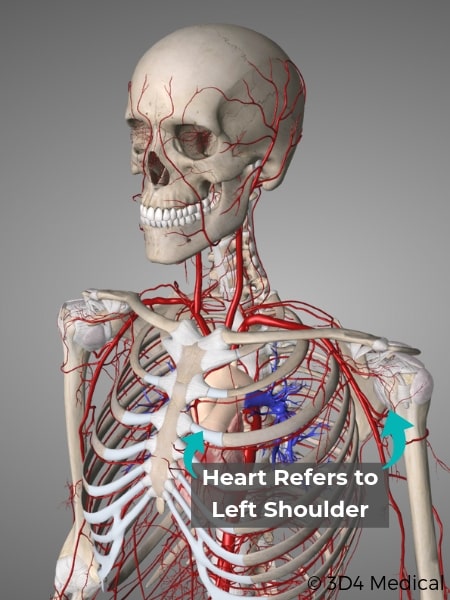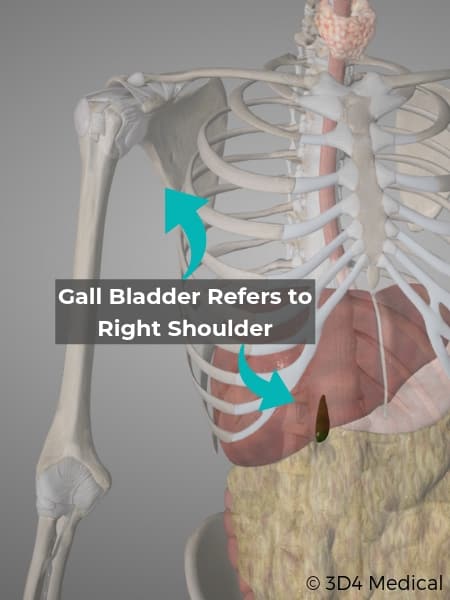When you come in and tell us you have “shoulder” pain – this can mean a number of things, because the “shoulder” can mean different things to you, compared to us.
JUMP TO:
1. Shoulder Pain Causes
2. Shoulder Pain Assessment
3. Shoulder Pain Diagnosis
4. Shoulder Pain Exercises
5. Shoulder Pain Relief
6. Shoulder Pain Prevention
7. What Does An Osteopath Do For Shoulder Pain
Typically the “shoulder” as a joint is just that – a ball and socket joint.
However, almost ALL “shoulder” pain is not in the actual shoulder joint itself.
It’s in front of, or beside, or near the shoulder blade, away from the joint.
So here are the ways we can tell where the pain is from.
1. Shoulder Pain Causes

Shoulder pain has several possible causes:
- The shoulder joint itself
- Referred pain from the neck
- Muscular tension around the shoulder
- Ligament strains and bursitis
- Rib joint pain
- Referred pain from organs
The shoulder joint is complex.
It’s a “ball and socket” type joint – like your hip – except it’s quite loose.
There are many structures in the shoulder joint that can causes pain – many muscles/tendons/ligaments
Your Osteopath will take a details case history, to find out all things related to your shoulder movement, and potential pathology.
The shoulder joint:
If there’s an issue with your shoulder joint itself, certain movements will make you worse, compared to other movements.
Nearly always – there’s other things that cause pain in the same region at the same time though. This is why it’s important to get seen/assessed.
Referred pain from the neck:
Lower neck issues and the nerves that supply the shoulder joint and skin may be the actual cause of shoulder pain.
C6 disc issues are a common presenting complaint, but most of the time the neck itself feels “fine” but – your SHOULDER is where you feel pain!!
There are specific movements that will tell us in literally seconds whether or not you have a disc issue in your neck.
Muscular tension around the shoulder:
Certainly very very common indeed!
Any of the rotator cuff muscles can cause shoulder pain. Sometimes they’re torn from either a direct injury, or simply from overuse.
Osteopaths look at all the reasons why that shoulder is causing pain.
Ligament strains and bursitis:
Ligament injuries are usually traumatic in origin. We pick that up in your history.
Bursitis is usually as a result of a chronic movement problem in your shoulder. It’s relatively common and requires a specific series of steps to help guide you out of it.
Rib joint pain:
Your upper ribs have joints where they join the spine, and these joints can become stiff, and they can definitely cause “shoulder pain”.
Very often missed, and mis-diagnosed as “rhomboid” (muscle) pain, when it’s not.
Believe it or not, rib (costovertebral) joint pain is the number one reason why people present to emergency at the hospital – thinking they’re having a heart attack!!
Referred pain from organs:
Several organs can give you shoulder pain, including the gall bladder, heart and lungs.
It’s only when we take a decent history, and have a thorough assessment that we can check for this.
Of course, the last place you want to be is in an Osteopaths/Physio/Chiro clinic if there’s a suspected organ referral of pain!
So – we refer you, to the appropriate place.
2. Shoulder Pain Assessment

Shoulder pain has many possible causes, with the most common being muscular and skeletal such as the joint.
Osteopaths will look at your shoulder based on the history.
History questions can include (but not limited to):
- How long have you had this pain?
- Where exactly is the pain?
- What does it feel like? i.e. is it sharp or achy etc
- Does it hurt to do any movements?
- Can you take the pain away?
If there is a genuine tear in a structure, the ways that you reproduce pain are going to match how we reproduce pain.
Sometimes, you’ll report pain in (for example) the front of your shoulder and you will be 100% sure the pain is underneath your finger.
But then – we can press somewhere else, and recreate your exact pain. We might be pressing the back of your shoulder, a long way away from the “pain”.
Sometimes you might do a specific movement and it hurts every single time.
Then we get you to activate another muscle BEFORE you do the same specific movement that caused pain.
But the pain is gone, or significantly less.
All of these “tricks” enable us to figure out whether or not you’ve got a pathology, and need referral for further examination or a diagnostic ultrasound.
But generally, before we go down this pathway, we’ve done the standard sequence of:
- History
- Active range of motion
- Passive range of motion
- Active resisted strength tests
- Special tests
There are quite a few other reasons for shoulder pain, so we’ve got our antennas up looking for multiple things that can cause pain.
3. Shoulder Pain Diagnosis

To diagnose shoulder pain, Osteopaths will:
Check active shoulder range of motion.
We’re trying to see how good your movement is. How far can you move your arm/hand above your head? Can you do it all the way forwards, to the side?
Is there pain at any point in movement? At what stage of the movement is it sore?
Check passive shoulder range of motion.
Can we take your shoulder through range?
Will your brain let us?
If it doesn’t – the overriding “self protection” mechanisms are at play – usually indicating a structure that’s injured such as joint, tendon, or ligament.
Check “active-resisted” muscle strength.
There are no “perfect” muscle tests.
Your brain is in control.
Therapists think that they are testing specific muscles – but in reality – they’re firing up or testing muscles that form part of a chain.
So we could do a “supraspinatus” (one of your rotator cuff muscles) test, and it’s positive… but is supraspinatus the ACTUAL issue?
Are we truly testing that muscle when in fact to do the test, we’re recruiting a whole lot of other muscles at the same time…
It’s the ability to see past the tests that makes an Osteopathic approach different to others
Check “special” Orthopaedic tests.
There are several tests which, when positive, lead us more down a path that requires you to possibly have another opinion, as manual therapy can only go “so far”.
When combining all the above, and looking at the possible reasons the pain is there, we can arrive at a shoulder diagnosis – but not always!!
Most of the time, shoulder pain is relatively straight forward, and can be treated by an Osteopath successfully.
4. Shoulder Exercises

There are no “one size fits all” exercises for the shoulder.
We can’t say how many times people are simply given a sheet of exercises with a stretchy band, and told to do them…
…but the exercises are painful, and make things worse!!
So, exercises have GOT to be specific to YOU.

There are so many exercises!
But – many of them are a WASTE OF TIME for most shoulder injuries, because they’re not specific for YOU!!
In fact, they can simply make you worse.
Sometimes – rotator cuff exercises are very very important. But not always.
Sometimes movement patterns are more effective – like rolling patterns, or looking at gait/walking patterns.
We look for patterns, and ways to help you body improve those patterns.
We look at the shoulder and it’s multiple muscles as part of a sequence.
You can never use any of your shoulder muscles in isolation. Ever.
So it’s pointless trying to find a “generic” solution to shoulder pain via exercise… sorry!
5. Shoulder Pain Relief

Shoulder pain relief can be attained quickly – depending on the cause. Most things are pretty straightforward, and respond quickly to Osteopathic treatment combinations.
If there isn’t too much inflammation or serious structural pain causes, shoulder pain can be relatively simple to sort out.
On occasion shoulder pain isn’t easy to fix or solve with manual therapy.
Pain could be from bone spurs in the joint, bursitis, arthritis, and many other things, that may not change with a few manual therapy treatments.
Medication for shoulder pain relief
Hopefully, you’ll understand that medication usually simply masks the causes of the problem.
It can really help your pain levels, there’s no doubt about that. But please understand that it may not fix the “reason” you’ve got that shoulder pain!
Osteopathy for shoulder pain relief
Osteopathic treatment for shoulder pain will only be effective if we’ve got a great history, and done a good assessment.
We’ve got to know what we’re dealing with to effectively help you with shoulder pain.
Exercises for shoulder pain relief
Exercises are almost always required to help shoulder pain, but can in some instances make you worse.
Osteopaths know the reasons why and when your shoulder pain can be made worse, so we take steps to help you a lot BEFORE you start exercises.
6. Shoulder Pain Prevention

Shoulder pain prevention can be so easy!
But – most people have issues that would have been much easier to prevent a few years earlier than when we see them!
The primary reason we see shoulder pain is from poor posture and this, is the actual reason the structures are NOW causing pain.
But how can you “fix” this?
The postural causes of shoulder (and neck) pain are really becoming so much worse than ever before, because of poor posture associated with our lifestyle.
Our lifestyle, from a very young age, promotes a “flexed” shoulder posture. We are glued to our devices from a very young age, and the resultant postural changes forces you to become “round shouldered”.
It’s a real problem.
We see this on a daily basis, and it’s so easy to prevent!!
For the most part, your upper back is supposed to allow you to ROTATE. When your spine is bent forwards, you simply lose rotation.
Over time, your body/brain gets “used to” this… and forces you to stay in this posture.
What most people don’t realise is that this posture in the SPINE actually affects the SHOULDER as well…
When your upper back is more curved, your shoulder joints follow, placing more strain in the shoulder when you do certain movements.
This, over time – can cause degenerative changes inside the joint, tendons and bursa structures, causing pain.
So of course, you could just get an injection, or take an anti-inflammatory, but that doesn’t stop the reason the pain is there!
Osteopaths know this, and try all ways to help prevent shoulder pain – before you even get it!
7. What Does An Osteopath Do Shoulders?

Manual therapy with an Osteopath can involve many standard “treatments” but we never EVER just look at your shoulder.
Osteopathic treatment of shoulder pain will be dependent on what you present with, and why.
After consideration as to the actual cause of your problem, typical Osteopathic treatment can/may involve a combination of:
- Soft tissue massage
- Joint mobilisation
- Dry needling
- Mobility exercises
- Stretches
- Ergonomic advice
The whole point of seeing an Osteopath for shoulder pain is to a) diagnose the problem, and b) do something about it.
Remember – an Osteopath will not ONLY prescribe exercises, and will not ONLY do manual therapy.
We take a global view as to WHY the shoulder problem is there, and provide you with a realistic solution.




